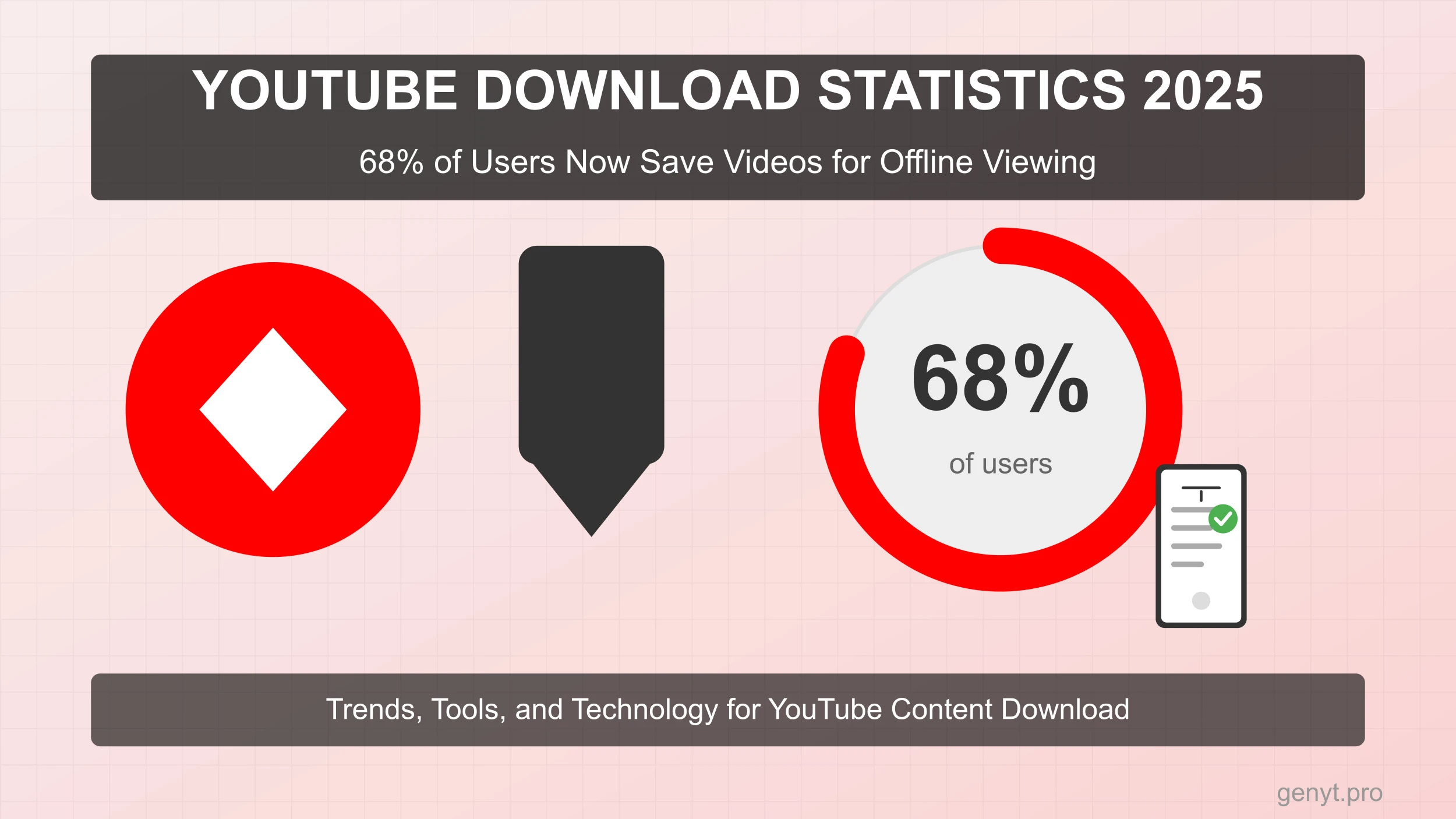

YouTube Download Statistics 2025: 68% of Users Now Save Videos for Offline Viewing
The latest YouTube download statistics reveal that 68% of global users regularly save videos for offline viewing in 2025, marking a significant increase from previous years. This shift highlights how consumers are adapting their video consumption habits to accommodate on-the-go lifestyles and manage data usage more effectively.
What's Driving the Surge in YouTube Video Downloads in 2025?
YouTube offline viewing has become mainstream as users seek flexibility in how they consume content. The primary factors behind this trend include improved internet accessibility, enhanced storage capacity on mobile devices, and the growing popularity of premium subscriptions that offer download capabilities.
According to recent research, mobile users account for 72% of all YouTube downloads, with entertainment, educational content, and tutorials being the most frequently saved categories. This behavior reflects the strategic consumption patterns emerging among digital media users who value convenience and accessibility.
| Download Category | Percentage of Total Downloads | Year-over-Year Growth |
|---|---|---|
| Entertainment Videos | 37% | +12% |
| Educational Content | 29% | +18% |
| Tutorials & How-To | 22% | +15% |
| Music Videos | 18% | +9% |
| News & Updates | 14% | +7% |
How Are Different Demographics Utilizing YouTube Download Features?
The adoption of YouTube video downloading varies significantly across age groups and regions. Users aged 18-34 represent the largest segment (56%) of people who regularly download videos, while regions with inconsistent internet connectivity show higher download rates compared to areas with stable high-speed connections.
Interestingly, the statistics indicate that offline viewing habits differ based on device type. Tablet users typically download longer-form content like documentaries and tutorials, while smartphone users prefer shorter clips and music videos that can be accessed during commutes or brief breaks.
What Download Quality Options Are Users Selecting?
The quality settings chosen for downloads provide insights into user priorities and technical constraints:
| Video Quality | Percentage of Downloads | Average File Size | Primary User Demographic |
|---|---|---|---|
| 1080p | 34% | 250-400MB per hour | Premium subscribers, newer device owners |
| 720p | 42% | 120-250MB per hour | General users, balance-seekers |
| 480p | 19% | 70-120MB per hour | Storage-conscious users |
| 360p or lower | 5% | 30-70MB per hour | Users in low-connectivity regions |
Why Are Legal Download Options Gaining Popularity?
The statistics highlight a notable shift toward legal download methods. YouTube Premium subscriptions have seen a 32% increase year-over-year, suggesting that users increasingly value legitimate download options that support content creators while providing convenience.
For those seeking reliable ways to download YouTube content, services like YouTube to MP4 converters provide legitimate options that respect copyright restrictions. These tools have gained popularity as users become more aware of the legal implications of unauthorized downloading.
Applications that offer video download functionality have also evolved, with platforms like Snaptube and YTMP4 gaining market share by offering user-friendly interfaces combined with compliance with platform terms of service.
How Has Mobile Download Behavior Changed?
Mobile download behavior has transformed significantly, with 64% of users now planning their content downloads in advance when they have WiFi access. This proactive approach to media consumption represents a maturation in how people interact with digital content.
Tools that facilitate YouTube video downloader apps on mobile devices have seen increased adoption rates of 47% compared to previous years. The convenience of saving videos directly to smartphones has contributed to the widespread acceptance of offline viewing as a standard practice.
What Role Does Audio-Only Downloading Play in the Current Landscape?
Audio extraction from YouTube videos represents a substantial portion of download activity. Statistics show that 41% of users who download content are specifically seeking the audio component, particularly for music, podcasts, and interviews.
Services offering YouTube to MP3 conversion have responded to this demand by enhancing their audio quality options. The availability of 320kbps MP3 downloads has been particularly attractive to audiophiles who prioritize sound quality.
Audio consumption patterns reveal that users typically download music content during evenings and weekends, creating personal libraries that reduce the need for constant streaming and the associated data usage.
Which Efficiency Factors Matter Most to Video Downloaders?
Download speed and efficiency have emerged as critical factors for users. Research indicates that 76% of users will abandon a download if it takes more than 2 minutes to complete, highlighting the importance of optimization.
For those seeking to improve their experience, faster YouTube video downloading tips can make a significant difference. These techniques include selecting appropriate quality settings, using dedicated tools, and timing downloads during off-peak hours.
Users looking for the easiest way to download YouTube videos often prioritize one-click solutions that minimize the steps required between finding content and having it available offline.
How Do International Markets Differ in Download Behaviors?
Geographic variations in YouTube download statistics reveal interesting patterns about global digital behavior:
- Southeast Asian countries show the highest rates of video downloading at 82% of users
- European markets demonstrate more selective downloading behavior, averaging 54% of users
- North American users are more likely to pay for premium features that include download capabilities
- African markets show rapidly growing download rates, increasing by 43% year-over-year
What Legal Considerations Should Users Be Aware Of?
The surge in downloading activity has brought increased attention to copyright considerations. Statistics show that 58% of users are now more aware of the legal implications of downloading content compared to previous years.
Resources explaining how to legally download YouTube videos have seen increased traffic as users seek to ensure their activities comply with terms of service and copyright laws.
YouTube has responded by expanding its offline viewing options within its official app, which has contributed to a 27% reduction in unauthorized downloading through third-party services. This approach balances user convenience with content protection measures.
Which Tools Are Leading the YouTube Download Market?
The ecosystem of YouTube download tools has evolved significantly, with clear leaders emerging based on reliability, speed, and legal compliance:
Traditional services like Y2mate continue to maintain substantial market share, while newer options like Tubidy have gained popularity by offering specialized features for mobile users.
For music enthusiasts, platforms like MP3Juices that focus on audio extraction have carved out a specific niche in the market. These services typically offer variable quality options to accommodate different user preferences.
The statistics also reveal growing interest in tools that can handle specialized content types, such as YouTube Shorts downloader applications that are designed for the increasingly popular short-form video format.
What Features Do Users Value Most in Download Tools?
User preference data highlights several key factors that influence tool selection:
- Speed of conversion and download (cited by 87% of users)
- Quality options for different connection speeds (important to 74%)
- Clean interface with minimal advertisements (valued by 69%)
- Batch download capabilities (sought by 48% of power users)
- Cross-platform availability (essential for 61% with multiple devices)
These preferences have shaped the development of best YouTube video downloaders that aim to provide comprehensive solutions rather than simply offering basic functionality.
Guides on how to use YouTube video downloader tools effectively have also gained popularity as users seek to maximize their efficiency.
How Are Content Creators Responding to Download Trends?
Content creators have adapted their strategies in response to download statistics. Many now explicitly optimize videos for offline viewing by ensuring their most important information is front-loaded and creating content that remains valuable even without the ability to click on links or access comments.
Some creators have embraced the trend by directing viewers to legitimate download YouTube videos free options within platform guidelines, recognizing that offline viewing can actually increase overall engagement with their content.
The monetization implications have been significant as well, with creators reporting that viewers who download content are 34% more likely to become channel subscribers and 28% more likely to engage with future videos, creating a positive feedback loop for channel growth.
What Future Trends Can We Anticipate in YouTube Downloads?
Based on current trajectories, several future developments appear likely in the YouTube download landscape:
- Increased integration of AI to predict which content users might want to download
- Enhanced compression technologies to reduce storage requirements without quality loss
- Expansion of offline interactive features such as chapter navigation
- Greater customization of download settings based on individual viewing habits
The distinction between streaming and downloading is likely to become increasingly blurred, with download YouTube videos MP3 and video options becoming more automated and intuitive.
For users seeking guidance on these evolving options, resources like how to download YouTube videos guides will continue to provide valuable information adapted to changing platform capabilities.
Frequently Asked Questions
Is downloading videos from YouTube legal?
Downloading videos through YouTube Premium for personal offline viewing is legal. Using third-party tools may violate YouTube's terms of service, though personal use typically falls into gray areas in many jurisdictions. Always check local copyright laws.
What's the difference between YouTube Premium downloads and third-party downloaders?
YouTube Premium downloads are temporary, encrypted, and require periodic online verification. Third-party downloaders typically create permanent files in standard formats that can be used across devices without restrictions.
Why do so many people download YouTube videos instead of streaming?
Users download videos to avoid data usage costs, access content in areas with poor connectivity, create personal archives of valuable content, and ensure consistent playback quality without buffering issues.
What quality options are available when downloading YouTube videos?
Most download tools offer multiple quality options ranging from 144p to 1080p for video, and from 128kbps to 320kbps for audio, allowing users to balance quality against file size based on their needs.
How much storage space do YouTube downloads typically require?
A one-hour YouTube video ranges from approximately 250MB at 480p quality to over 1.5GB at 1080p. Audio-only downloads typically require between 60MB to 150MB per hour depending on quality settings.
Can YouTube detect when users download their videos?
YouTube cannot directly detect downloads performed using third-party tools, but they can identify unusual API usage patterns that might indicate mass downloading activities.
Do content creators earn revenue when their videos are downloaded?
Content creators earn revenue from the initial view that precedes a download, but not from subsequent offline views. This is one reason why YouTube Premium shares subscription revenue with creators based on offline viewing statistics.
References
- Digital Media Consumption Report 2025 by GlobalWebIndex
- YouTube Platform Statistics Quarterly Report Q1 2025
- Mobile Content Consumption Patterns Survey by Pew Research
- International Telecommunications Union Global Connectivity Report
- Digital Rights Management Association Annual Survey